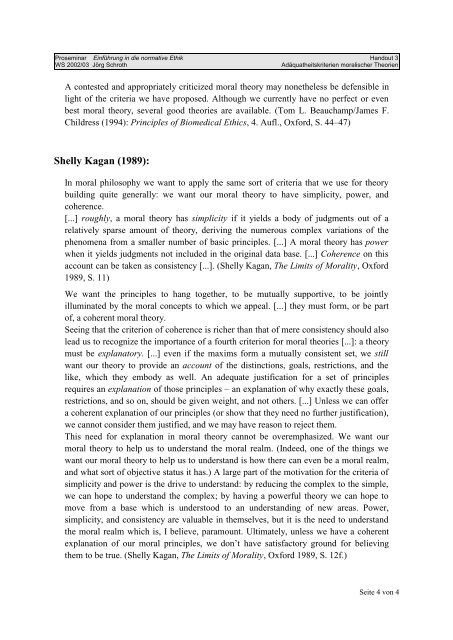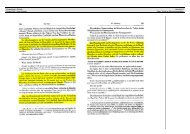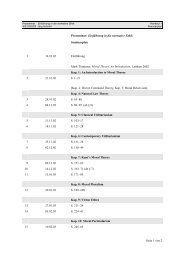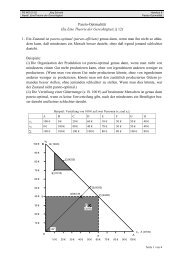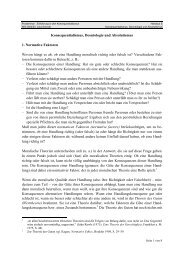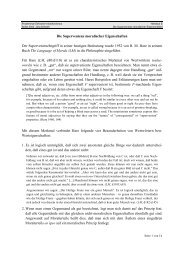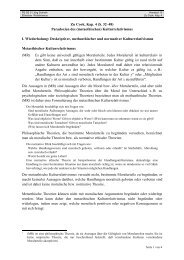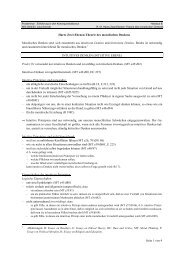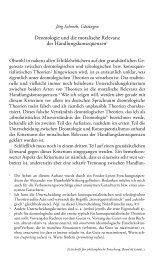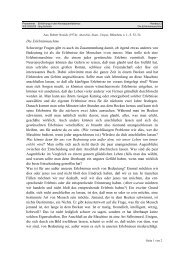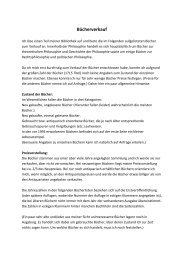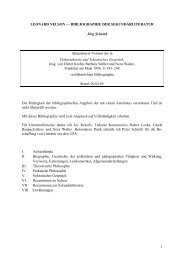Adäquatheitskriterien für moralische Theorien - Jörg Schroth
Adäquatheitskriterien für moralische Theorien - Jörg Schroth
Adäquatheitskriterien für moralische Theorien - Jörg Schroth
You also want an ePaper? Increase the reach of your titles
YUMPU automatically turns print PDFs into web optimized ePapers that Google loves.
Proseminar Einführung in die normative Ethik Handout 3<br />
WS 2002/03 <strong>Jörg</strong> <strong>Schroth</strong> <strong>Adäquatheitskriterien</strong> <strong>moralische</strong>r <strong>Theorien</strong><br />
Acontested and appropriately criticized moral theory may nonetheless be defensible in<br />
light of the criteria we have proposed. Although we currently have no perfect or even<br />
best moral theory, several good theories are available. (Tom L. Beauchamp/James F.<br />
Childress (1994): Principles of Biomedical Ethics, 4. Aufl., Oxford, S. 44–47)<br />
Shelly Kagan (1989):<br />
In moral philosophy we want to apply the same sort of criteria that we use for theory<br />
building quite generally: we want our moral theory to have simplicity, power, and<br />
coherence.<br />
[...] roughly, amoral theory has simplicity if it yields abody of judgments out of a<br />
relatively sparse amount of theory, deriving the numerous complex variations of the<br />
phenomena from asmaller number of basic principles. [...] Amoral theory has power<br />
when it yields judgments not included in the original data base. [...] Coherence on this<br />
account can be taken as consistency [...]. (ShellyKagan, The Limits of Morality, Oxford<br />
1989, S. 11)<br />
We want the principles to hang together, to be mutually supportive, to be jointly<br />
illuminated by the moral concepts to which we appeal. [...] they must form, or be part<br />
of, a coherent moral theory.<br />
Seeing that the criterion of coherence is richer than that of mere consistencyshould also<br />
lead us to recognize the importance of afourth criterion for moral theories [...]: atheory<br />
must be explanatory. [...] even if the maxims form amutually consistent set, we still<br />
want our theory to provide an account of the distinctions, goals, restrictions, and the<br />
like, which they embody as well. An adequate justification for aset of principles<br />
requires an explanation of those principles –an explanation of why exactly these goals,<br />
restrictions, and so on, should be given weight, and not others. [...] Unless we can offer<br />
acoherent explanation of our principles (orshow that theyneed no further justification),<br />
we cannot consider them justified, and we may have reason to reject them.<br />
This need for explanation in moral theory cannot be overemphasized. We want our<br />
moral theory to help us to understand the moral realm. (Indeed, one of the things we<br />
want our moral theory to help us to understand is how there can even be amoral realm,<br />
and what sort of objective status it has.) Alarge part of the motivation for the criteria of<br />
simplicity and power is the drive to understand: by reducing the complex to the simple,<br />
we can hope to understand the complex; by having apowerful theory we can hope to<br />
move from a base which is understood to an understanding of new areas. Power,<br />
simplicity, and consistency are valuable in themselves, but it is the need to understand<br />
the moral realm which is, Ibelieve, paramount. Ultimately, unless we have acoherent<br />
explanation of our moral principles, we don’t have satisfactory ground for believing<br />
them to be true. (Shelly Kagan, The Limits of Morality, Oxford 1989, S. 12f.)<br />
Seite 4 von 4


